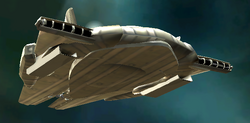JFO-2 Fighter
| |
|---|---|
| Official name |
Juxta Fighter Optimistics II |
| Designers |
Juxta Designs |
| Status |
In developement |
| Operators | Gammetan Air Force |
| Type |
Interceptor |
| Announcement | |
| First test flight |
(expected) Summer 2011 |
| Length |
14.25 m |
| Width |
7.75 m |
| height |
1.5 m |
| Hull material |
Trinium Turbide (640% refinement) |
| Hull density |
2 |
| Shield name |
planned, unconfirmed |
| Sensor range | Long range: 8 km Short range: 2.3 km |
| Targeting | |
| Targeting range |
2 km (aprox) |
| Navigation | |
| Comunication range | Long range: 720 km Medium range: 130 km Short range: 5 km |
| Crew |
1 |
| Propulsion |
8 Ligh V4 engines |
| Guns |
2 GPCs, unstated type. |
The JFO-2 Fighter (JFO-2 Interceptor, JF interceptor, FJFO) is an in-developement, repulsor and jet engine light interceptor designed by Juxta Designs for the Gammetan Air Force. They are being designed to travers space, but variants are also planned should the craft be a success.
Developement[]

A JFO-2 with it's weapons in view
In June 2010, when the craft was proposed, the HelAux F16 was the only craft in the Gammetan Air Force which was capable and designed for air-to-air engagement, however performed largely better in atmospherical combat than expected. Being a fighter, the F16 was also far from a proper substitute for an interceptor, which proved itself during the two Kortorisan-Techian wars.
The Gammetan Air Force sent out a request for a space-optimized interceptor in May 2010. Many were proposed, but the JFO-2 was chosen due to it being compact in size and weight, as well as being so narrowly-assigned. The craft was funded heavily during early developements, and by the end of August 2010, a prototype seemed likely - the engineers had already completed a schematic of it, but were still "dotting some 'I's, crossing some 'T's." With such a low in hostilites after the Techian, Ichiri and Alsoras wars added to the lack of needing a strong military, the Air Force cut it's fundings, forcing Juxta Designs to pull back its estimated prototype completion from September 2010 to February 2011. Then again, in December 2010, the prototype was pulled back further to summar 2011.
Currently, weapons are being heavily considered, as the expansion of the Gatalon Photon Cannon manufacturing industry means that more and more diverse models of the cannon are being created, making it difficult to chose an optimal one.
Design[]

An early JFO-2 design with the 8 Ligh Engines on show
Avionics[]
The JFO-2's concept during 2010, like most other Gammetan craft, had little avionics. However, with the steady growth of the economy, things like artificial intelligence became more and more available. Said avionics are yet to be implemented, however once released, the craft is said to be updated with a lot of them.
The craft's cockpit features a relatively big window, minimizing the fatality if ever the sensors were to go down, and thus the pilot would have to rely on his or her vision. Inside the cockpit, the pilot has the majority of controls readily available to him, such as yaw, pitch, roll and speed controls - the former two being on one control and the latter two being on the other - as well as an open cannon control, minimizing the time between the pilot realizing they need to fire and when they actually do fire. There are also controls for the two wing-mounted cargo holds, should they need to be jetesoned so that the battery can last longer or some other reason.
The primary speed control dictates only the 8 Ligh V4 engines: there is another seperate control for the two semi wing-mounted thruster engines, which can provide an emmense boost (past 10 Mach at ground level) and assist in inter-medium travel such as between atmosphere and space.

A side-on view of the JFO-2
There are three heads-up-displays beside each other right infront of the pilot. The leftmost screen shows a fully rotatable (and movable to a point) schematic of the fighter, including a real-time display of the status of various systems around the ship. Added to this, it automatically displays notifications on the screen to tell the pilot what is wrong, which means the pilot can concentrate more on combat rather than malfunction or damage diagnosis. The middle screen shows a simple spherical, zoomable and rotable area around the ship which displays any pre-determined pathways which the craft has been pre-programmed, such as attack runs or follow-ons to commanding ships or craft, as to assist in keeping a squadron together who cannot see each other visually for whatever reason. The rightmost screen has optional displays of real time (to the millisecond update) radar signatures, as well as an automatically placed targetting system range outlines, weapon range outline, and projectile signatures. Information is constantly sent from craft-to-craft about projectiles fired (and said craft can be deactivated so that if an enemy salvages a ship, it would not appear as if his/her projectiles were friendly) as to clear up any confusion between friendly and enemy missiles or other dangerous projectiles. All the displays on the rightmost screen are optional, so one can, for instance, see only projectiles instead of ships. The middle and right screens are attached, and only have a computer-generated border between them, which allows merging for a better and/or more comprehensive view.
